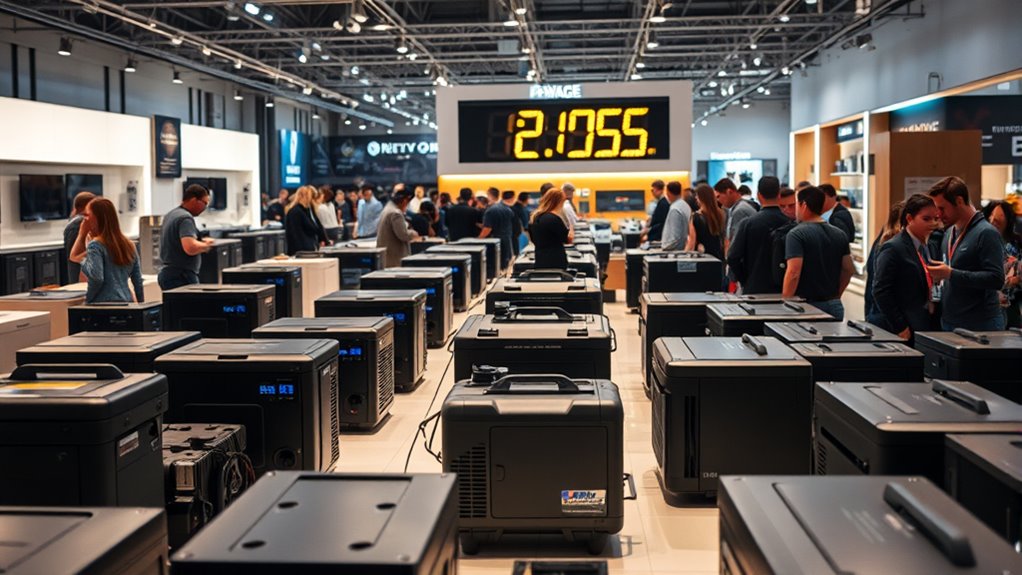Power outage backup systems are seeing record sales as more people recognize the need for reliable power. With increasing power outages due to extreme weather and aging infrastructure, households and businesses are turning to backup solutions. The demand for modular UPS systems and eco-friendly battery-based options is rising. You’ll discover how technological innovations and a growing reliance on smart devices are shaping this evolving market and driving these impressive sales trends.
Key Takeaways
- Increasing power outages due to extreme weather and aging infrastructure drive demand for reliable backup power systems.
- The modular UPS market is projected to grow significantly, indicating rising consumer interest in backup solutions.
- Technological advancements, including battery efficiency and integration with renewable energy, enhance the appeal of backup systems.
- Businesses and households face disruptions during outages, making dependable backup solutions essential for maintaining normalcy.
- Eco-friendly battery-based systems are gaining popularity over traditional generators, contributing to record sales of backup power solutions.

As power outages become more frequent due to extreme weather and aging infrastructure, the demand for backup power systems continues to soar. You’re likely noticing this trend, especially in the United States, where the market for backup power systems is experiencing significant growth. The increasing reliance on technology and home appliances means more households are seeking reliable power solutions to keep their lives running smoothly.
The global modular uninterruptible power supply (UPS) market exemplifies this shift, projected to grow from USD 5,841.4 million in 2025 to USD 12,898.1 million by 2035. This rapid expansion is driven by the increasing need for uninterrupted power in sectors like IT and healthcare. You’ll find that the rise of data centers, along with the integration of renewable energy sources, is a major factor fueling this growth. If you’re in the market for backup solutions, you may want to evaluate how these innovations can meet your needs.
Technological advancements are also reshaping the landscape of backup power systems. Integrating renewable energy sources and energy storage systems into these solutions is becoming more common. Modular UPS systems offer the flexibility and scalability that many businesses crave. Advances in battery technology are making them more efficient, which is vital if you rely heavily on uninterrupted power.
With smart home devices becoming increasingly popular, the demand for residential backup solutions is only going to grow.
The impact of power outages can’t be underestimated. Frequent outages disrupt business operations and critical infrastructure, leading to lost productivity and financial losses. If you’re in a region prone to extreme weather, having a reliable backup power system isn’t just a convenience; it’s a necessity. For residential users, power outages can disrupt daily life, making dependable backup solutions essential.
When it comes to options, modular UPS systems stand out for their efficiency and scalability. While portable and stationary generators are common, they come with drawbacks like fuel dependency and safety concerns. Battery-based backup systems, on the other hand, are gaining traction due to their eco-friendliness and reduced environmental impact.
Frequently Asked Questions
How Long Can Backup Systems Power Essential Devices During an Outage?
During a power outage, backup systems can typically power essential devices for 5 to 30 minutes.
If you’ve got a higher-capacity UPS, it might last several hours depending on your device’s power requirements and the battery size.
For example, laptops could run for 15 minutes to an hour, while low-power devices like modems might last longer.
To maximize runtime, calculate your total wattage needs and choose the right UPS accordingly.
Are There Maintenance Requirements for Power Outage Backup Systems?
Maintaining power outage backup systems is like keeping a car running smoothly; regular check-ups are essential.
You need to conduct monthly inspections, test batteries, and verify ventilation systems.
Don’t forget to monitor temperatures and test generators as part of your routine.
Follow NFPA 110 requirements and create a schedule for preventive maintenance.
Can Backup Systems Be Used in Extreme Weather Conditions?
Yes, backup systems can definitely be used in extreme weather conditions. They help you maintain uninterrupted operations by providing power when the grid fails.
You’ll find options like battery storage and solar-powered systems that guarantee essential services, like HVAC and security, stay operational.
With proper maintenance and customization, these systems enhance your resilience against weather disruptions, safeguarding your data and guaranteeing safety during challenging times.
What Is the Average Lifespan of a Power Outage Backup System?
Think of a power outage backup system as a trusty guardian, standing vigilant against the darkness.
On average, these systems can last anywhere from 5 to 15 years, influenced by factors like temperature and usage.
Uninterruptible Power Supplies (UPS) often boast lifespans of up to 10 years, while lithium-ion batteries shine with 3,000 to 5,000 charge cycles.
How Do I Choose the Right Backup System for My Needs?
To choose the right backup system for your needs, start by listing the devices you want to power and their wattages.
Determine how long you’ll need them running during an outage, then calculate your total energy consumption.
Look for systems that provide pure sine wave output and integrate with solar panels.
Consider battery type, charging methods, and expandability.
Finally, balance cost with reliability to guarantee you get a dependable solution.
Conclusion
As the storm clouds of uncertainty gather, you’ll find solace in the steady hum of your backup power system, a lighthouse guiding you through the dark. These record sales reflect not just a trend, but a collective awakening to the need for resilience. You’re not just investing in a piece of equipment; you’re securing peace of mind. When the lights flicker and fade, you’ll be ready, standing strong like a tree rooted deep in the ground.










